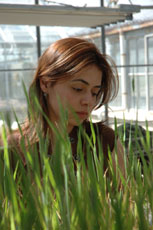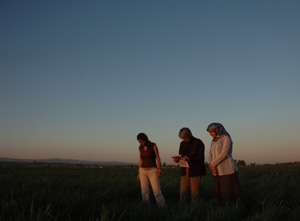CIMMYT E-News, vol 4 no. 6, June 2007
CIMMYT helps build scientific strength in Turkey.
When you first meet Gul Erginbas and Elif Sahin standing side by side in an experimental wheat plot in Turkey, what stands out are the differences between them. One is dressed very traditionally, head and body covered, the other is in close-fitting denim jeans. It seems these two young postgraduate students could not be less alike. But when it comes to science the external differences disappear. These are two committed and talented young people who hope to make a difference in their own country. They are already making a difference for CIMMYT.
“I really depend on them,” says Julie Nicol, the CIMMYT soil-borne disease pathologist, based in Turkey. “We work in close collaboration with the Turkish Ministry of Agriculture and several universities. Both women have started working on their doctoral degrees, supervised by key university experts and myself. This is a highly effective way to build capacity in applied research both for Turkey and the world.” Having bright and committed students on the ground is also very beneficial to CIMMYT.
The Anadolu Research Institute at Eskisehir is one of Turkey’s oldest and most important agricultural research stations, especially for winter wheat breeding. It is about a three-hour drive east of the capital city, Ankara, on the broad and rolling Anatolian plateau. At this station CIMMYT (together with ICARDA and Turkey) works in winter wheat breeding and also in Nicol’s area of specialization, finding ways to reduce the threat to wheat from pathogens in the soil, the microscopic worms and fungi that cause damage underground long before the impacts are seen in the part of the wheat plant that is above the ground.
Both Sahin and Erginbas have supervisors at their own universities in Turkey but having a CIMMYT scientist like Nicol as a co-advisor really helps. “She brings us a global perspective and makes sure we work with care and precision,” says Elif. “And she really knows the field. It is easy to learn from her,” adds Gul. “With this experience, I hope I can contribute to science in Turkey in the future.”
 Erginbas is just beginning work on a project to screen wheat for resistance to a disease called crown rot. It is caused by a microscopic fungus in the soil called Fusarium culmorum (related to but not the same as the Fusarium fungus that causes head blight in wheat) and can cause farmers serious loss of yield. Her first tests have been with plants grown in a greenhouse on the station. Later she will expand her work to the field and as part of her program will spend some time in Australia with the Commonwealth Scientific and Industrial Research Organization (CSIRO). Since there is some evidence that the fungus that causes crown rot can survive for up to two years in crop residues, there is a great interest in this work as more farmers adopt reduced tillage and stubble retention on their land.
Erginbas is just beginning work on a project to screen wheat for resistance to a disease called crown rot. It is caused by a microscopic fungus in the soil called Fusarium culmorum (related to but not the same as the Fusarium fungus that causes head blight in wheat) and can cause farmers serious loss of yield. Her first tests have been with plants grown in a greenhouse on the station. Later she will expand her work to the field and as part of her program will spend some time in Australia with the Commonwealth Scientific and Industrial Research Organization (CSIRO). Since there is some evidence that the fungus that causes crown rot can survive for up to two years in crop residues, there is a great interest in this work as more farmers adopt reduced tillage and stubble retention on their land.
Sahin is focusing on an underground pest called the cereal cyst nematode, a tiny worm that can cause great damage to the root system of the plant. It can be responsible for losses of up to 40% of rainfed winter wheat in Turkey and there is evidence that the nematodes are very widespread in west Asia, North Africa, northern India and China. Sahin, funded by a scholarship from the Turkish funding body TUBITAK, is looking for sources of resistance to the pest.
 These pathogens are especially damaging when wheat is grown under more marginal conditions, and so the work in Turkey that these two young students are doing may have its greatest impact where farmers struggle the most.
These pathogens are especially damaging when wheat is grown under more marginal conditions, and so the work in Turkey that these two young students are doing may have its greatest impact where farmers struggle the most.
For more information: Julie Nicol, pathologist (j.nicol@cgiar.org)
 Climate adaptation and mitigation
Climate adaptation and mitigation 
